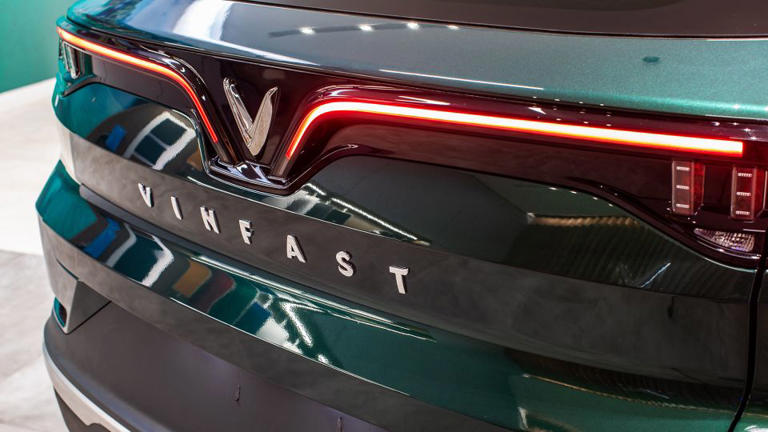VinFast VF8 crash, VinFast EV accident, fatal VinFast SUV crash, NHTSA investigation, automated steering failure, electric vehicle crash, ADAS safety, VinFast safety issues, VinFast VF8 fire, VinFast automated driving
Federal regulators are investigating a fatal crash in California involving a VinFast VF8 electric SUV, which resulted in the deaths of four occupants. The investigation focuses on the SUV’s automated steering features, previously reported as problematic by the vehicle’s owner. This article explores the details of the incident, the investigation by NHTSA, and the broader implications for automated driving technologies.

Introduction
Federal regulators are currently investigating a tragic crash in California involving a VinFast VF8 electric SUV, which resulted in the deaths of four occupants. The Vietnamese automaker, VinFast, founded in 2017, has rapidly made a name for itself in the automotive industry, particularly with its electric vehicles. This incident, however, has brought attention to potential issues with the automated steering features of the SUV, which the vehicle’s owner had previously reported problems with. This article delves into the details of the crash, the investigation, and the broader implications for automated driving technology.
The Incident
The crash occurred when the VinFast VF8, driven by a coworker of the vehicle’s owner, veered off the road, hitting a pole and then a tree before catching fire. The fatal accident claimed the lives of all four occupants, including two children seated in the back. The details were disclosed in a complaint filed on the National Highway Traffic Safety Administration’s (NHTSA) website by someone claiming to be the vehicle’s owner.
According to the complaint, the vehicle owner had previously experienced issues with the SUV’s automated steering. In at least two instances, the SUV had unexpectedly steered to the right while the owner was driving. In one of these instances, the automatic driving assistance features were reportedly activated by default, causing concern for the owner who managed to regain control and steer the vehicle back into the proper lane.
Investigation by NHTSA
NHTSA’s Special Crash Investigations unit, which focuses on incidents involving new technologies or unusual circumstances, is tasked with documenting the crash and the resulting fire. The unit’s role is critical in understanding whether the automated driving assistance systems (ADAS) in the VinFast VF8 played a role in the fatal crash.
The investigation is part of a broader effort by NHTSA to scrutinize the safety of ADAS across various automakers, including Tesla and Ford, which have also been involved in incidents where these systems were operational at the time of accidents. The complexity of the VinFast VF8 crash highlights the ongoing challenges in ensuring the safety and reliability of automated driving technologies.
VinFast’s Response
In response to the investigation, VinFast has stated that they are cooperating fully with NHTSA to determine the causes of the accident. The company emphasized that NHTSA is not specifically investigating VinFast as a company but is looking into the crash circumstances. Additionally, VinFast noted that the Pleasanton police are conducting their own investigation and will release their findings upon completion.
Automated Driving Assistance Systems Under Scrutiny
The crash brings to light the critical issues surrounding the deployment and reliability of ADAS. These systems, designed to enhance vehicle safety by assisting with steering, braking, and lane-keeping, have been under intense scrutiny due to several high-profile accidents. While ADAS can significantly reduce the likelihood of accidents caused by human error, their reliability and safety in real-world conditions remain a concern.
In the case of the VinFast VF8, the owner’s previous complaints about the automated steering system raise questions about the adequacy of the technology and the effectiveness of the safety measures in place. The fact that the system reportedly activated by default and caused unintended steering maneuvers suggests potential flaws in the design or implementation of the technology.
Broader Implications for the Automotive Industry
The fatal crash involving the VinFast VF8 underscores the broader implications for the automotive industry as it increasingly incorporates advanced technologies into vehicles. Automakers are in a race to develop and deploy autonomous and semi-autonomous driving systems, promising increased safety and convenience for drivers. However, incidents like this highlight the need for rigorous testing, validation, and regulatory oversight to ensure these technologies do not introduce new risks.
The investigation by NHTSA and the response from VinFast will likely contribute to the ongoing discourse on the safety of automated driving systems. As more vehicles with ADAS hit the roads, it is crucial for manufacturers and regulators to work together to address any shortcomings and enhance the reliability of these systems.
Conclusion
The tragic crash involving a VinFast VF8 electric SUV has prompted a federal investigation into the role of automated steering features in the accident. With four lives lost, including two children, the incident serves as a stark reminder of the potential dangers associated with emerging automotive technologies. As NHTSA and VinFast work to uncover the causes of the crash, the findings will be instrumental in shaping the future of automated driving systems and ensuring the safety of all road users.
The broader implications of this investigation extend beyond VinFast, impacting the entire automotive industry as it navigates the complex terrain of innovation and safety. The pursuit of advanced vehicle technologies must be balanced with robust safety measures and regulatory oversight to prevent such tragedies and build public trust in the next generation of transportation.
Read More-
- OpenAI Pulls ChatGPT AI Voice Over Its Resemblance to Scarlett Johansson in the Movie Her
- Biden Campaign Grassroots Momentum: April Fundraising and Strategic Investments
- US Rejects Global Tax on Billionaires: Implications and International Reactions
- Robert Costello Clash with Judge in Trump Trial: Impact on Michael Cohen Credibility